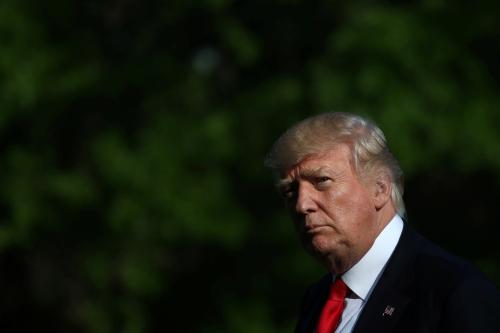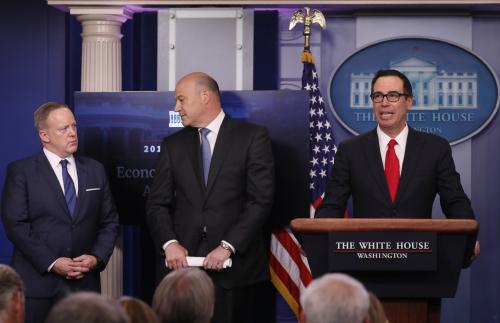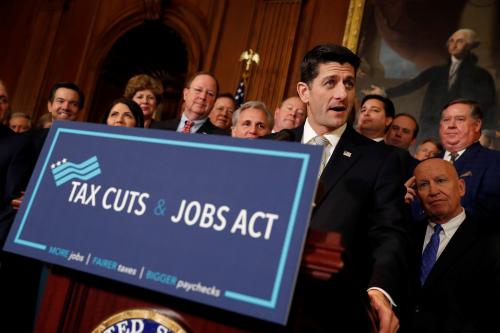This explainer was originally published in May 2017. It was updated in December 2018 by David Wessel and Jeffrey Cheng to reflect the latest available data.
The federal government spent nearly $4.1 trillion—one out of every five dollars in the U.S. economy—in the fiscal year that ended Sept. 30, 2018. Read on for a glimpse into how the government spent and earned its money in 2018.
Where does the government spend all that money?
About two-thirds of the budget goes to mandatory spending, programs for which the government does not set a spending cap in advance, but, instead, provides specified benefits to everyone who meets the eligibility criteria. For example, once Congress sets the rules for Medicare—the health insurance program for the elderly—the exact amount of spending varies from year to year based on the size of the elderly population and how much or how little they use heath care services.
The other third of federal outlays, discretionary spending, is determined by Congress on an annual basis. Agencies cannot spend more than the sums appropriated by Congress. For example, funding for National Aeronautics and Space Administration (NASA) is discretionary, which means that every year Congress decides how much federal money to authorize it to use—in 2018, $19.5 billion. NASA then has to operate within that budget.

So what programs fall under mandatory spending?
About half of mandatory spending is spending on programs primarily aimed at the elderly. Social Security pays a monthly old-age benefit to those reaching retirement age (minimum 62), whereas Medicare pays for the health care expenses for those 65 and older. Social Security and Medicare also provide benefits to disabled individuals and families of retired, disabled, and deceased workers.
Next up is Medicaid, the health care program for the poor run jointly by the state and federal governments, and income security programs like unemployment insurance and food stamps. “Other mandatory programs” include an array of much smaller programs that range from federal government and military retirees’ benefits to veterans’ pensions. And last but not least, a portion of mandatory spending goes to interest payments on the federal debt.

Why do we spend so much on interest?
The government has borrowed a lot: The federal debt held by the public amounted to slightly over $15 trillion by the end of 2018, a sum equivalent to roughly 76 percent of the U.S. economy. This level of debt is very high by historical standards. The only previous experience with debt this high was at the end of World War II. As a result, a sizable part of the budget goes to pay interest on that debt—in 2018, interest consumed almost 8 percent of all federal spending. This is more than what the federal government spent on unemployment benefits, higher education, food and nutrition assistance programs, and pollution control taken together.
What about the discretionary spending? What does that include?
About half of discretionary spending goes to defense. In 2017, the most recent year for which data is readily available, U.S. defense spending exceeded that of the next seven countries combined. Defense spending by the U.S. accounted for over a third of worldwide defense spending even though the U.S. economy is only about a fifth of the world economy. Yet U.S. defense spending in 2017 was a smaller share of the world’s military spending than in previous years. For example, during the 2001-2011 decade, the U.S. accounted for about 40 percent of world military spending.
The other half of discretionary spending includes everything from space exploration to salaries of folks who answer phones at the Internal Revenue Service: education and employment, transportation, veterans’ healthcare, administration of justice, and other programs as diverse as international affairs, FBI, and housing assistance. International affairs spending, which includes a wide range of activities from international development and humanitarian assistance to international military assistance, accounts for only 1 percent of all federal spending. Spending for education, training, employment, and social services also represents a relatively small share—just 3 percent —reflecting the fact that most public spending on education is at the state and local level.

Where does the government get all this money?
In 2018, federal revenues amounted to $3.3 trillion. Most of that came from individual income taxes (49 percent) and the payroll taxes levied to finance Social Security and Medicare (35 percent).The remainder came from the corporate income tax (7 percent) and a hodgepodge of other taxes (9 percent) including the estate and gift taxes and taxes on alcohol, tobacco and firearms known as excise taxes. 
Who pays the largest share of federal taxes?
In 2018, the top 20 percent of earners received 53 percent of all income before taxes and paid 68 percent of all federal taxes. Within this top 20 percent, the top one percent of earners paid 26 percent of all federal taxes while receiving 16 percent of total pre-tax income, and the top 0.1 percent paid slightly more than 13 percent of all taxes and received a pre-tax income share of about 8 percent.

The type of taxes paid varies a lot across the income distribution too. While the bottom half of earners contributed little to revenue in income taxes, they did contribute significantly in payroll taxes. Seventy percent of the income taxes were paid by people with incomes above $200,000 per year. In contrast, over 70 percent of the payroll taxes were paid by people with annual incomes below $200,000.
How does the size of the government in the U.S. compare to that in other advanced economies?
To compare the size of government across countries, it makes sense to examine all levels of government, so as to ensure an apples-to-apples comparison. In 2018, revenues collected by all levels of government in the United States—federal, state, and local—amounted to 26 percent of the size of the U.S. economy. That’s a much smaller share than in most other advanced economies. For instance, total government revenues represented 33 percent in Canada, 37 percent in Germany, and 46 percent in France.
Has the federal government been getting bigger?
Not much. Although federal spending varies from year to year, in response to both business cycles and changes in legislation, the overall trajectory hasn’t shown a strong upward trend over the past 50 years, measured against the size of the economy. For example, outlays were 20.6 percent of the economy in 2018, just a bit higher than the 20.2 percent average over the past 50 years. Similarly, federal revenues were about 16.6 percent of GDP in 2018, a bit lower than the 17.4 percent 50-year average. The difference, of course, is the budget deficit.






Commentary
The Hutchins Center Explains: Federal budget basics
December 13, 2018